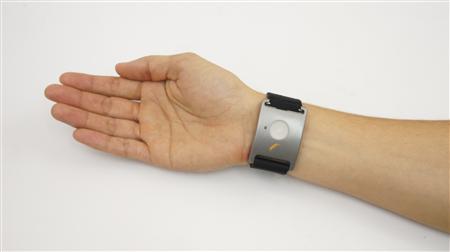(Reuters) – The Bill & Melinda Gates Foundation, which has poured more than $4 billion into efforts to transform public education in the U.S., is pushing to develop an “engagement pedometer.” Biometric devices wrapped around the wrists of students would identify which classroom moments excite and interest them — and which fall flat.

The foundation has given $1.4 million in grants to several university researchers to begin testing the devices in middle-school classrooms this fall.
The biometric bracelets, produced by a Massachusetts startup company, Affectiva Inc, send a small current across the skin and then measure subtle changes in electrical charges as the sympathetic nervous system responds to stimuli. The wireless devices have been used in pilot tests to gauge consumers’ emotional response to advertising.
Gates officials hope the devices, known as Q Sensors, can become a common classroom tool, enabling teachers to see, in real time, which kids are tuned in and which are zoned out.
Existing measures of student engagement, such as videotaping classes for expert review or simply asking kids what they liked in a lesson, “only get us so far,” said Debbie Robinson, a spokeswoman for the Gates Foundation. To truly improve teaching and learning, she said, “we need universal, valid, reliable and practical instruments” such as the biosensors.
IS AROUSAL A SIGN OF LEARNING?
Skeptics aren’t so sure. They call the technology creepy and say good teachers already know when their students are engaged. Plus, they say it’s absurd to think spikes in teenagers’ emotional arousal necessarily correspond to learning.
“In high school biology I didn’t learn a thing all year, but boy was I stimulated. The girl who sat next to me was gorgeous. Just gorgeous,” said Arthur Goldstein, a veteran English teacher in New York City who has long been critical of Gates-funded education reform.
The engagement pedometer project fits neatly with the Gates Foundation’s emphasis on mining daily classroom interactions for data. One of the world’s richest philanthropies, the foundation reflects Microsoft founder Bill Gates’ interest in developing data collection and analysis techniques that can predict which teachers and teaching styles will be most effective.
The Gates Foundation has spent two years videotaping 20,000 classroom lessons and breaking them down, minute by minute, to analyze how each teacher presents material and how those techniques affect student test scores.
The foundation has also asked 100,000 kids around the country detailed questions about their teachers: Does she give students time to explain their ideas? Does he summarize the lesson at the end of class? That data, again, will be correlated with test scores to try to identify the most effective teaching styles.
The foundation has spent $45 million on such research, under the umbrella name Measures of Effective Teaching.
‘MEASUREMENT MANIA’
The engagement pedometer is not formally part of that program; the biosensors are intended to give teachers feedback rather than evaluate their effectiveness, said Robinson, the Gates spokeswoman.
Still, if the technology proves reliable, it may in the future be used to assess teachers, Robinson acknowledged. “It’s hard for one to say what people may, at some point, decide to do with this,” she said.
That alarms some educators who have long been critical of the Gates Foundation’s efforts to boil down effective teaching to an algorithm.
“They should devote more time to improving the substance of what is being taught … and give up all this measurement mania,” said Diane Ravitch, an education professor at New York University.
Ravitch blogged about the biosensor bracelets a few days ago after a critic of the Gates Foundation flagged the grants on Twitter. Her posts generated a small storm of angry commentary online, with some teachers joking that they would have to start screaming at random intervals or showing the occasional soft porn film to keep arousal rates among their students sufficiently high.
In fact the sensors do not distinguish between fear and interest, between boredom and relaxation, so researchers plan to videotape each class that uses the biosensors. That way they can see what was happening in the classroom at moments of peak engagement.
“It could be that the bell rang or that someone sneaked up behind you,” said Shaundra Daily, an assistant professor in the School of Computing at Clemson University, in South Carolina, who is setting up the middle-school research.
Clemson received about $500,000 in Gates funding. Another $620,000 will support an MIT scientist, John Gabrieli, who aims to develop a scale to measure degrees of student engagement by comparing biosensor data to functional MRI brain scans (using college students as subjects). A third grant, for nearly $280,000, supports research by Ryan Baker, a Columbia University professor who specializes in mining data about educational practices.
POTENTIAL FOR MISSION CREEP
Daily and others working on the project say it’s still far too early to tell if biosensor bracelets will be effective. But they can envision many ways to use the technology, which is sometimes referred to as “galvanic skin response measurement.”
Teachers could, for instance, use the bracelets to monitor student response to a video or a reading, then use that data to spark a lively discussion by zeroing in on the most engaging points, said Rosalind Picard, a computer scientist at MIT and a co-founder of Affectiva, which makes the sensors.
Educators could also deploy the sensors to test different approaches: Are ninth-grade algebra students more engaged by an online lesson, by math-related video games, or by a traditional teacher lecture at the blackboard?
To Sandi Jacobs, the promise of such technology outweighs the vague fear that it might be used in the future to punish teachers who fail to engage their students’ Q Sensors.
Any device that helps a teacher identify and meet student needs “is a good thing,” said Jacobs, vice president of the National Council on Teacher Quality, an advocacy group that receives funding from the Gates Foundation. “We have to be really open to what technology can bring.”
(Editing by Jonathan Weber and Prudence Crowther)





